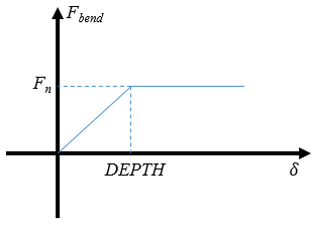/INTER/TYPE8
Block Format Keyword This interface is used to simulate drawbeads. It is mainly used in the process industry to model metal forming.
Drawbeads are used to prevent the metal strip from sliding during the stamping process. Normals of the main segments must be oriented toward the secondary nodes (unsorted group).
Format
| (1) | (2) | (3) | (4) | (5) | (6) | (7) | (8) | (9) | (10) |
|---|---|---|---|---|---|---|---|---|---|
| /INTER/TYPE8/inter_ID/unit_ID | |||||||||
| inter_title | |||||||||
| grnd_IDs | surf_IDm | Iform | |||||||
| Fn | Ft | DEPTH | Tstart | Tstop | |||||
| Blank Format | |||||||||
Definitions
| Field | Contents | SI Unit Example |
|---|---|---|
| inter_ID | Interface
identifier (Integer, maximum 10 digits) |
|
| unit_ID | Unit Identifier (Integer, maximum 10 digits) |
|
| inter_title | Interface
title (Character, maximum 100 characters) |
|
| grnd_IDs | Secondary unsorted node
group identifier. (Integer) |
|
| surf_IDm | Main surface
identifier. (Integer) |
|
| Iform | Friction penalty
formulation type.
(Integer) |
|
| Fn | Drawbead normal force per
unit length. (Real) |
|
| Ft | Drawbead restraining force
per unit length. (Real) |
|
| DEPTH | The drawbead
depth. (Real) |
|
| Tstart | Start time for contact
impact computation. (Real) |
|
| Tstop | Temporary deactivation
time. (Real) |
Comments
- The node group for secondary surface must be an unsorted group (/GRNOD).
- Iform =1 is not available when using Idt =1 in option /ADMESH/GLOBAL.
- When Fn ≠ 0, Normal force is computed. The normal force is due to the bending of the blank into the draw bead as the binder closes on the die. The total contact force is the sum of the restraining force and normal force.
- Fn represents
a limiting value. The normal force begins to develop when the distance
d between the blank and drawbead line is less than the
drawbead depth (DEPTH). When the drawbead is close to blank (distance equal to depth), this normal
force reaches a plateau Fn. The
value of normal force depends on the penetration as described here:

Figure 1.Where, .
- If DEPTH = 0 or stiffness, the slope of the linear part of the curve is reset to the stiffness of the blank so that the same time step than the one without normal force is used to guarantee the stability.